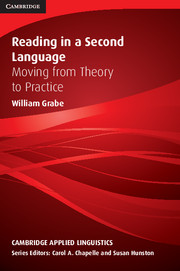Book contents
- Frontmatter
- Contents
- Series editors' preface
- Preface
- I FOUNDATIONS OF READING
- II PATTERNS OF VARIATION IN READING
- III DEVELOPING READING COMPREHENSION ABILITIES
- IV EXPANDING READING COMPREHENSION SKILLS
- Chapter 14 Reading fluency, reading rate, and comprehension
- Chapter 15 Extensive reading
- Chapter 16 The reading curriculum and instruction
- Chapter 17 Reading assessment
- Chapter 18 Further topics and issues in reading
- References
- Author Index
- Subject Index
Chapter 17 - Reading assessment
from IV - EXPANDING READING COMPREHENSION SKILLS
Published online by Cambridge University Press: 05 August 2012
- Frontmatter
- Contents
- Series editors' preface
- Preface
- I FOUNDATIONS OF READING
- II PATTERNS OF VARIATION IN READING
- III DEVELOPING READING COMPREHENSION ABILITIES
- IV EXPANDING READING COMPREHENSION SKILLS
- Chapter 14 Reading fluency, reading rate, and comprehension
- Chapter 15 Extensive reading
- Chapter 16 The reading curriculum and instruction
- Chapter 17 Reading assessment
- Chapter 18 Further topics and issues in reading
- References
- Author Index
- Subject Index
Summary
An understanding of the principles and uses of assessment is essential for all teachers, and in particular for teachers of reading.
(Snow, Griffin, & Burns, 2005: 179)Reading assessment has great power to inform researchers, teachers, administrators, and policy makers. Assessment practices can significantly benefit the learning environment or they can inflict great harm. Reading assessment, therefore, needs to be treated with great care, attention, and respect. Teachers, especially, have a responsibility to understand the uses and the impacts of reading assessment and be mindful of the consequences of assessment.
Reading assessments are used for many purposes, but all appropriate uses begin from an understanding of the reading construct, an awareness of the development of reading abilities, and an effort to reflect the construct in assessment tasks. The first five chapters of this book, in effect, represent a reasonable interpretation of the construct of reading ability. Chapters 10 through 15 describe key aspects of the reading development process. The complexity of the construct of reading, as well as its development, also reveals the potential complexity of reading assessment.
Reading assessment can be intimidating and sometimes overwhelming for many teachers and administrators; thus, a first goal of this chapter is to present a straightforward framework that categorizes the many uses and purposes for assessment. A fairly simple, yet thorough framework should allow readers to sort through their own assessment experiences in a way that gives interpretive force to the framework. The chapter then outlines and describes a number of major options under each category in the assessment framework.
- Type
- Chapter
- Information
- Reading in a Second LanguageMoving from Theory to Practice, pp. 352 - 375Publisher: Cambridge University PressPrint publication year: 2008



